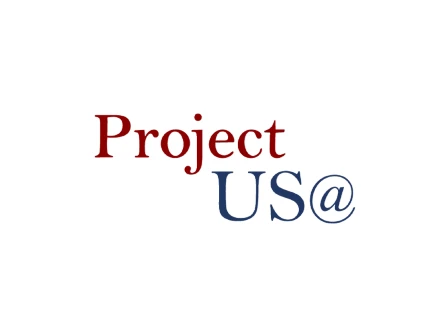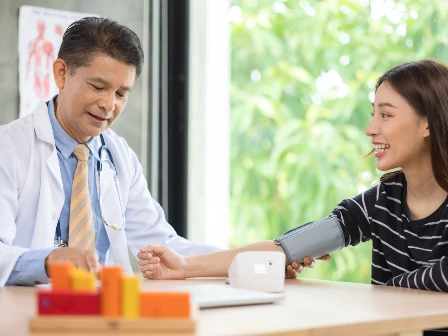Project US@ healthcare address standardization | What it is, why it matters

Project US@, (or Project USA) is a pioneering initiative with technical guidelines and standards to address the challenges surrounding address standardization processes in the healthcare industry. Project US@'s mission is to improve the accuracy and quality of patient addresses, leading to more effective patient matching with shared records between hospitals, specialists, pharmacies, and other private and public health organizations.
Address standardization might not be the most thrilling topic in healthcare, but it's a crucial puzzle piece that's been missing for far too long. Imagine a world where every hospital, clinic, and medical practice speaks the same addressing language. That's the future that Project US@ aims to build.
Smarty™ provides address standardization and validation tools to improve address data quality. Try them out now, or continue reading to learn about Product US@.
| Single Address Validation | Project US@ Format API | Project US@ Documentation |
|---|---|---|
In this article we'll cover:
- What problems does Project US@ help solve
- USPS vs. Project US@ formatting
- The benefits of project US@
- Simplifying patient data standardization with Project US@
- Frequently asked questions about project US@
- The future of enhanced healthcare
What problems does Project US@ help solve?
The lack of a unified address standardization process in healthcare has led to a convoluted mess. Picture this: Every hospital and medical facility has its own way of entering addresses into its systems. This variation might appear inconsequential, but it's the root cause of several pressing issues that ripple through the industry. Here are some specific challenges:
Incorrect patient matching
Think about the journey of a patient seeking specialized care. When a general practitioner needs to forward a patient's medical history to a specialist, the differing address formats between the two practices can lead to unnecessary confusion. Instead of a seamless transfer, a new patient record might be created in the specialist's system, causing confusion and potential medical errors.
Project US@ seeks to bring coherence to this chaos by implementing a consistent address standardization protocol–no more lost patient histories or confusion due to mismatched addresses.
Compromised patient data quality

Address discrepancies have a domino effect, extending their reach into the heart of patient data quality. Inaccurate addresses can lead to misdirected communication, missed appointments, and even misplaced medical files. Project US@ aims to bolster the foundation of patient data accuracy, ensuring that every piece of information reaches its intended destination with precision.
Challenges in population health analytics
In a data-driven age, accurate analytics form the bedrock of informed decision-making. However, the prevalence of duplicate patient records due to address inconsistencies skews population health analytics. This distortion can misrepresent patient demographics, treatment outcomes, and hospital performance. Project US@ seeks to recalibrate this imbalance, allowing health professionals to draw meaningful insights from clean, standardized data.
USPS vs. Project US@ formatting
We thought it would be helpful to show some examples of the changes that come with Project US@. Below, you can see the differences between the USPS and Project US@ formatting standards.
| USPS format | Project US@ format | Differences |
| 1 King St Apt 1 New York NY 10012-2927 | 1 KING ST APT 1 NEW YORK NY 10012-2927 | All letters capitalized |
| 99 1/2 1st St Riverside IA 52327-7742 | 99 1/2 1ST ST RIVERSIDE IA 52327-7742 | All letters capitalized |
| 123 Hwy 124 E Hallsville MO 65255-9415 | 123 HIGHWAY 124 E HALLSVILLE MO 65255-9415 | "Highway" in the street name always spelled out |
| 123 CR 532C Bushnell FL 33513-3458 | 123 COUNTY ROAD 532C BUSHNELL FL 33513-3458 | "County" in the street name always spelled out |
| 5317 I 55 N Jackson MS 39206-4105 | 5317 INTERSTATE 55 N JACKSON MS 39206-4105 | "Interstate" in the street name always spelled out |
The benefits of Project US@
In healthcare, small changes can yield monumental improvements. Project US@ is no exception—it's a game-changer that promises many benefits, transforming the healthcare landscape for the better. Let's delve into the remarkable advantages of this initiative.
Enhanced patient privacy and HIPAA compliance

Patient privacy is paramount in healthcare, and Project US@ understands that implicitly. By standardizing addresses, the initiative aligns with the stringent requirements of the Health Insurance Portability and Accountability Act (HIPAA). Patient identifiers, a crucial aspect of HIPAA, are handled with utmost care, ensuring that sensitive information remains secure and confidential. With standardized patient address data, the risk of improper handling or exposure of patient data is significantly reduced, fostering an environment of trust and compliance.
Seamless integration into the Qualified Health Information Network (QHIN)
Becoming a part of the Qualified Health Information Network (QHIN) brings many advantages that you shouldn't ignore. As a network designed to facilitate secure and efficient health data exchange, QHIN offers numerous benefits to healthcare organizations. The catch? Standardized addresses through Project US@ are a prerequisite for participation. Here's why being part of QHIN is a strategic move:
- Enhanced interoperability: In the era of a connected healthcare ecosystem, interoperability is key. QHIN ensures that standardized data can flow seamlessly between different healthcare systems, enabling comprehensive patient care without the constraints of data silos.
- Efficient data exchange: By ensuring that all participating entities adhere to standardized address formats, QHIN enables a swift and accurate exchange of health information. This translates to quicker decision-making, reduced administrative burden, and, ultimately, improved patient outcomes.
- Heightened data security: Security breaches in healthcare can have dire consequences. QHIN's stringent security measures, combined with standardized addresses, provide a robust defense against data breaches, safeguarding patient information from unauthorized access.
- Comprehensive insights: Being part of QHIN grants access to a rich pool of aggregated health data. Clean, standardized addresses ensure the accuracy and reliability of this data, enabling accurate population health analytics and informed decision-making.
Simplifying patient data standardization with Project US@
Project US@ helps to manage and untangle the web of address variations in healthcare. Let's peek behind the curtain and uncover the mechanics driving this innovative initiative.
Guiding health IT stakeholders and healthcare staff

At its core, Project US@ is all about providing practical guidance. Health information professionals crafting health IT systems and healthcare professionals recording patient data are the driving forces behind the initiative. By offering a clear roadmap for precise address matching, Project US@ empowers these stakeholders to ensure that your organization's healthcare journey is seamless and accurate at every step.
Technical specification and AHIMA companion guide
Project US@ comes armed with two powerful tools: the Project US@ technical specification and the Project US@ AHIMA companion guide. These resources are designed to bring uniformity to the management of patient address data. Consistency of addresses will supercharge patient matching algorithms, making it easier for systems to discern if multiple records belong to the same individual. This not only streamlines processes but also boosts data quality.
Harnessing USPS expertise
When it comes to addresses, the USPS reigns supreme. Leaning on their expertise, Project US@ aligns with USPS postal standards and was originally designed to enhance mail deliverability. By integrating USPS standards, the initiative taps into a wealth of address knowledge and applies it to healthcare data. This unique collaboration ensures that the address data's accuracy and reliability are second to none.
Unified technical specification
Project US@ thrives on unity. Crafted through a partnership between ,Health Level Seven (HL7) International, the National Council for Prescription Drug Programs (NCPDP), X12, and 18 standards development organizations (SDOs), the initiative's unified technical specification is a testament to industry collaboration. It's built upon the foundation of USPS Publication 28, preserving the benefits of improved mailability while elevating the quality of patient addresses for effective matching. This alleviates the developer's burden and enhances patient query and matching efficiency.
Reducing developer burden
Streamlining processes is one of Project US@'s main objectives. Many healthcare systems have adopted USPS Publication 28 through third-party address validation solutions such as Smarty.
By aligning with this standard, Project US@ minimizes the burden on health IT developers. The project saves them from reinventing the wheel and reduces challenges related to patient query efficiency, record de-duplication, billing error investigation, and more.
Frequently asked questions:
To quickly help answer some common queries, we'll address a few key questions related to Project US@:
How did Project US@ get its start?

Project US@ was born from a need to streamline healthcare processes. It aims to guide software developers and healthcare staff in accurately matching patient data by standardizing addresses. It leverages existing postal standards to enhance patient care by teaming up with experts like USPS.
Why is Project US@ important for improved patient matching?
Project US@ matters because it ensures accurate patient matching. With standardized addresses, healthcare systems can quickly identify if multiple records belong to the same patient. This reduces confusion, minimizes errors, and leads to more effective patient care.
Why is address data still so bad?
Address data inconsistency arises due to the lack of a universal standard. Different healthcare practices use various formats, causing problems in patient matching, data quality, and analytics—Project US@ steps in to fix this by introducing a standard approach.
How does Project US@ fit into the US's health IT infrastructure?
Project US@ integrates seamlessly into the US's health IT landscape. Based on USPS standards, it offers clear guidance through technical specifications and the AHIMA Companion Guide. Collaborating with industry leaders and aligning with existing solutions reduces the burden on developers and enhances patient data accuracy across the board.
The future of enhanced healthcare
Only time will tell if Project US@ can stand as a force for standardization, efficiency, and patient-focused progress in the dynamic healthcare landscape.
While the concept of address standardization might appear straightforward, its influence extends across a broad spectrum. From enhancing patient matching accuracy to bolstering data security, from ensuring HIPAA compliance to seamlessly integrating into the Qualified Health Information Network (QHIN), Project US@ seeks to illuminate areas where confusion has long prevailed.
By offering guidance to developers and healthcare professionals, tapping into USPS expertise, and collaborating with industry pioneers, Project US@ aims to lay a foundation where precise, standardized patient data flows effortlessly. Its goal is to eradicate the complexity arising from diverse address formats and usher in an era where patient records glide seamlessly alongside patients.
However, the true essence of Project US@ will reside in its technical prowess and its dedication to improving the patient experience. Through standardized addresses, the intricate tapestry of healthcare operations gains efficiency, errors can be minimized, and data becomes a potent asset for informed decision-making.
With this journey just starting, who could have anticipated that addresses would play such an important role in the healthcare narrative?
As we discuss champions, when it comes to Project US@ implementation, Smarty will be one of the first companies in the world with the ability to implement Project US@ into your systems. If you'd like to learn more about Project US@, reach out to our sales team or test out our US@ in our US Street Address API tool. We're here to address your questions and assist you on your journey toward improved healthcare data management.